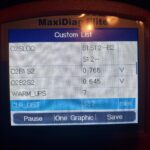Deciphering your car’s check engine light can feel like trying to understand a foreign language. That little light illuminating on your dashboard is your vehicle’s way of communicating that something isn’t quite right. Fortunately, the language it speaks is OBD2, and with an Obd2 Diagnostic Codes List, you can start to understand what your car is trying to tell you. Welcome to your comprehensive resource for navigating the world of OBD-II codes.
OBD-II (On-Board Diagnostics II) is a standardized system used in vehicles to monitor and diagnose engine and emission control systems. When your car detects an issue, it generates a diagnostic trouble code (DTC), which is a standardized alphanumeric code. These codes are the key to understanding the problem. The most common codes you’ll encounter are Powertrain codes, starting with P, but there are also codes for Body (B), Chassis (C), and Network/Communication systems (U).
Understanding OBD2 Code Categories
OBD2 codes are categorized by the first character in the five-character code:
- P – Powertrain Codes: These are the most frequent and relate to the engine, transmission, and related components.
- B – Body Codes: These codes pertain to systems within the vehicle body, such as airbags, power windows, and central locking.
- C – Chassis Codes: Chassis codes relate to systems like ABS (Anti-lock Braking System), steering, and suspension.
- U – Network/Communication Codes: These codes indicate problems with the communication network within the vehicle’s electronic systems.
Within the “P” category, you’ll find further distinctions:
Generic Powertrain Codes (P0xxx, P2xxx, P3xxx)
These P0___, P2___, and P3___ codes are considered generic, meaning they are standardized across all vehicle manufacturers. They cover a wide range of common powertrain issues. Due to the extensive list of generic codes, they are often organized into subcategories based on the second character (e.g., P01xx for fuel and air metering issues). To find your specific code within these ranges, detailed lists are typically categorized for easier navigation.
Manufacturer Specific Powertrain Codes (P1xxx)
If your code starts with P1___, it signifies a manufacturer-specific powertrain code. While the “P” still indicates powertrain, these codes are defined by the specific vehicle manufacturer (like Ford, GM, Toyota, etc.). These codes often pinpoint issues that are unique to a particular make or model. To accurately diagnose a P1___ code, consulting manufacturer-specific resources is crucial.
Understanding your OBD2 diagnostic codes list is the first step in addressing your vehicle’s issues. While this list provides a starting point, remember that proper diagnosis often requires further investigation and, when in doubt, consulting a qualified mechanic is always recommended. Use this information to become better informed about your vehicle’s health and ensure its longevity.
